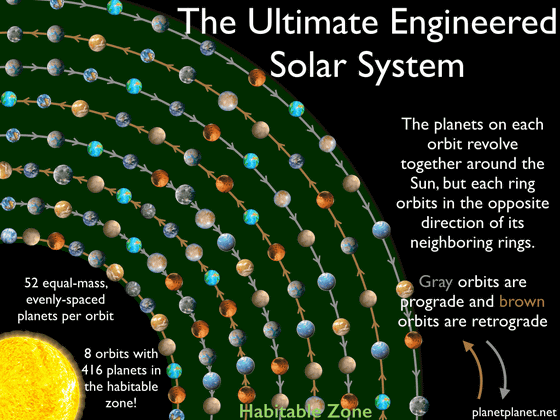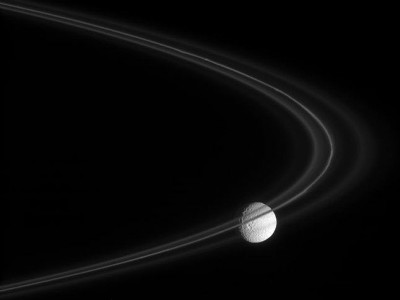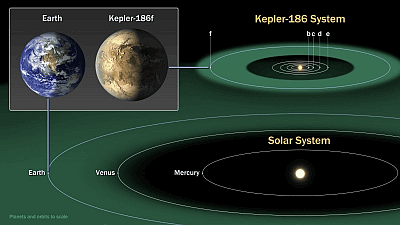This is what happens when astronomers seriously think about the 'ultimate solar system'

Sean Raymond, an American astrophysicist living in France who studies the formation and evolution of planetary systems, posts a series called ``Building the Ultimate Solar System'' on his blog ``PLANETPLANET''. At the conclusion of the series, Raymond says, ``We have built a planetary system with as many habitable worlds as possible'' and shows what kind of solar system it will become.
The Ultimate Engineered Solar System – PLANETPLANET

Build a better Solar System – PLANETPLANET
https://planetplanet.net/2013/06/11/build-a-better-solar-system/
Building the ultimate Solar System – PLANETPLANET
https://planetplanet.net/2014/05/13/building-the-ultimate-solar-system/
Raymond begins by saying in a post titled ``Building a better solar system'' that ``the solar system is a shame.'' There is only one planet in the solar system that has forests and oceans and is inhabited by humans. Jupiter's moons Europa and Ganymede are thought to have liquid water, but it's hidden beneath meters of ice. Also, Saturn's moon Titan has an atmosphere and lakes, but they are made of liquid ethane instead of water. Although traces of liquid water have been confirmed on the surface of Mars, it is now a barren desert.
So Raymond started a thought experiment: ``Maximize the number of habitable worlds by replacing the solar system.'' The rules for this are: ``You can use as many things that actually exist in the solar system as there are,'' and ``You must preserve the orbits of the solar system, the number of planets and asteroids, and the orbits of satellites around the planets. There are two points: 'It is prohibited to draw a trajectory.'
Below is an image of the solar system's planets and their respective satellites organized according to scale.

In relocating these celestial bodies, Raymond focused on ``liquid water,'' which is an essential condition for the birth of life in the solar system. To do this, a celestial body containing water or ice must be placed in the habitable
The celestial bodies that could potentially support life if placed in the habitable zone are Earth, Venus, Mars, Jupiter's moons Ganymede and Europa, Callisto , Saturn's moon Titan, Neptune's moon Triton , and several others. It is an asteroid.
As a result of organizing these, Mr. Raymond shows the following diagram as a ``better solar system.'' First, we placed Mars in the current orbit of Venus, in a hot, dry position closest to the sun in the habitable zone shown in green. The Earth's position has not changed, but it has swapped satellites with Saturn, giving Saturn a moon and Earth a Titan. Jupiter is located at the outermost part of the habitable zone, and in addition to Jupiter's moons Europa and Ganymede, the asteroids Eris and Venus are located. As a result, 'we can now think of seven habitable worlds,' Raymond said.

Satisfied with optimizing the solar system, Raymond then embarked on a thought experiment: ``Building the ultimate solar system with as many habitable worlds as possible.'' We are eliminating the initial rule of ``using the solar system's celestial bodies and orbits as they are'' and are considering a method of ``packing habitable celestial bodies and orbits to the extent possible within the solar system.'' The important point is that if the planets get too close, their orbits will become unstable due to the influence of each other's masses. Also, if the orbits are too close, the repeated effects of gravity will slowly extend the orbits, and eventually the orbits will intersect, causing a collision or being blown into interstellar space.
The range of influence of gravity around a celestial body is called a Hill sphere , and it is thought that the planet's orbit can be stabilized by separating it by the radius of the Hill sphere. According to Raymond, in the case of the solar system, if we consider the Earth's Hill sphere, six concentric orbits fit into the habitable zone. In other words, it is thought that 6 Earth orbits can be placed within the habitable zone, but ``What is important here is that ``at least 6 Earths'' can be placed in 6 orbits, not ``up to 6 Earths.'' ” Raymond said.

Raymond also cited a paper published in 2010 by Andrew Smith of Stanford University's Department of Mechanical Engineering and Jack Rezauer of the National Aeronautics and Space Administration's research center as a ``study that shocked me.'' According to this study, a minimum of 7 Earths and a maximum of 42 Earths can be placed in one orbit.
Smith and his colleagues ran a simulation with 42 Earths, the maximum number that could actually fit along the Earth's orbit, and found that it would be perfectly stable for billions of years. In response to this paper, Mr. Raymond conducted a unique simulation and confirmed that it worked.
In conclusion, it is thought that ``42 terrestrial planets in six orbits, a total of 252 habitable planets'' will remain in the habitable zone and remain stable. However, the number of planets that can be placed in orbit is affected by the mass of the planet, so in the case of Mars, whose mass is about one-tenth that of Earth, there would be 89 planets in 13 orbits, for a total of 1157 planets, which is about 10 If it were twice as large as Neptune or Uranus, there would be 19 planets in three orbits, for a total of 57 planets.

Mr. Raymond finally shows the following diagram as the 'ultimate solar system'. Here, in order to arrange the maximum number of planets while being as stable as possible, various types of celestial bodies are placed on eight orbits, resulting in a total of 416 planetary systems. It is almost impossible for the number of planets to be arranged like this in an actual star system, and if this were to happen, it would have been intentionally designed by a super-intelligent advanced civilization, so Mr. Raymond calls this model the ``ultimate.'' It is called the ``Artificial Solar System''.

Related Posts:
in Science, Posted by log1e_dh







